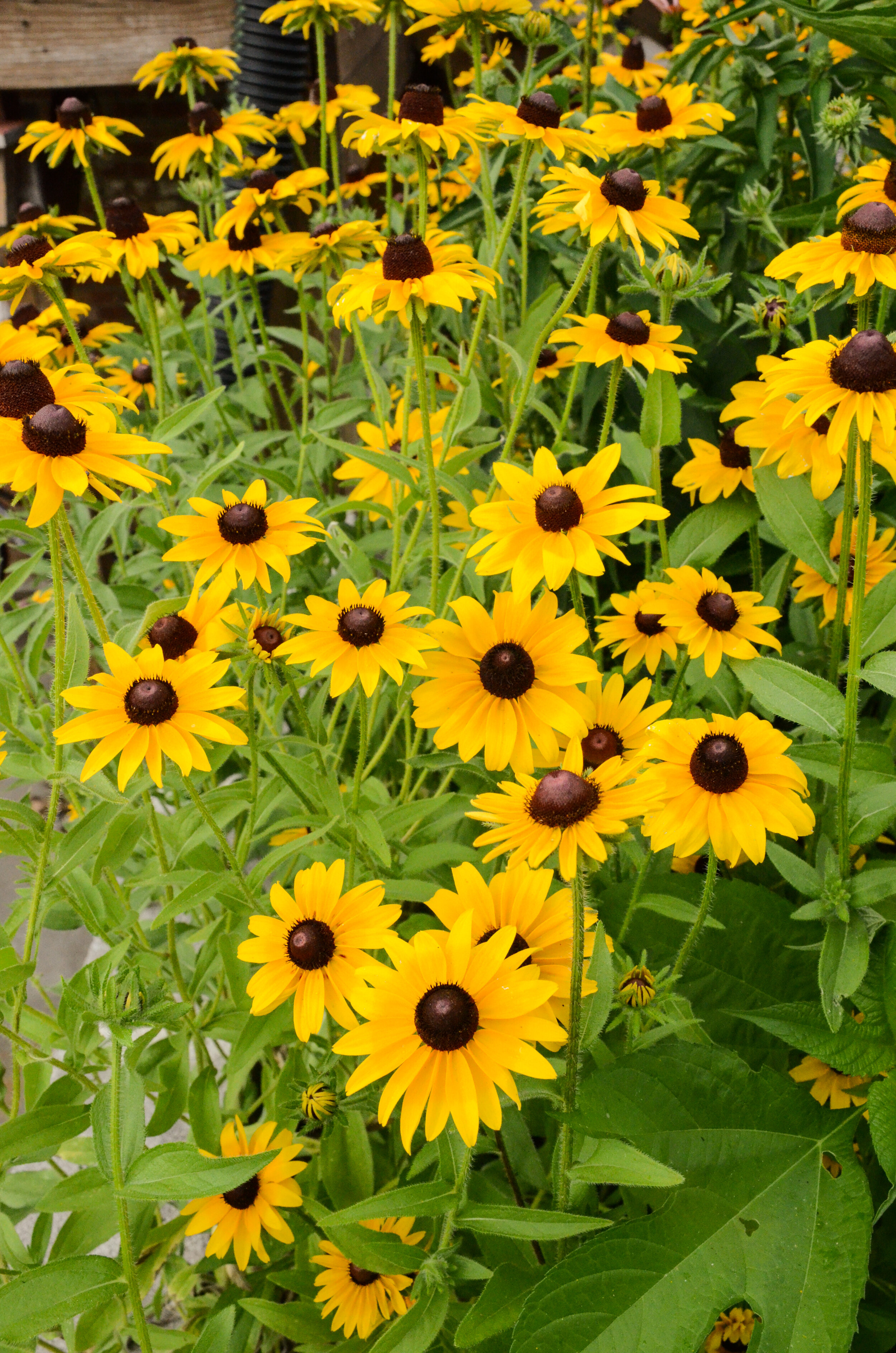Top Summer Perennials
Here’s a list of my favorite summer-blooming perennials for attracting birds, butterflies, and bees. These plants are tough as nails and provide habitat for all kinds of pollinators!
purple coneflower (Echinacea purpurea)
1. Purple Coneflower (Echinacea purpurea)
Hardiness zones: 3-9
Why I like it: Echinacea is probably my favorite native perennial. Goldfinches, butterflies, and bees all love this plant. It’s great for a wildflower meadow or a border and tolerates full sun to light shade.
black-eyed susan (Rudbeckia hirta)
2. Black-eyed Susan (Rudbeckia hirta)
Hardiness zones: 3-9
Why I like it: Black-eyed susans are super hardy! Plant them once and they’ll come back year after year, spreading seeds as they go. They also attract goldfinches, butterflies, and provide habitat for insects. The more sun they get, the bigger they’ll grow. If you want to attract birds, steer clear of Rudbeckia gloriosa, which is not as beneficial as R. hirta.
orange butterflyweed (Asclepias tuberosa) and zebra swallowtails (Protographium marcellus)
3. Orange Butterflyweed (Asclepias tuberosa)
Hardiness zones: 3-9
Why I like it: This native milkweed is drought tolerant, loves the sun, and is a great medium-sized addition to any bed or border. Best of all, it attracts MONARCHS! Orange butterflyweed plants can grow 2-3 feet in all directions, getting bigger and bushier each year. It’s a must for any native perennial garden!
woodland sage (Salvia nemorosa)
4. Woodland Sage (Salvia nemorosa)
Hardiness zones: 5-9
Why I like it: Sage is a staple in any garden. It’s practically unkillable, attracts lots of bees, and its tall spikes compliment lots of other flowers. I like all Salvia varieties, but woodland sage is one of my favorites. Even though woodland sages come in small containers at garden centers, they’ll grow more than three feet in each direction if given enough space and sunshine!
garden speedwell (Veronica longifolia) and zebra swallowtail (Protographium marcellus)
5. Garden Speedwell (Veronica longifolia)
Hardiness zones: 4-10
Why I like it: Garden speedwell is another one of my super hardy staples. Plant it once and watch the butterflies and bees all summer long, year after year! It looks great paired with coreopsis, echinacea, or orange butterflyweed.
garden phlox (Phlox paniculata)
6. Garden Phlox (Phlox paniculata)
Hardiness zones: 4-8
Why I like it: Garden phlox comes in a variety of colors, ranging from white to red to purple to lavender. The huge globes of flowers remind me of hydrangeas and make great “filler flowers” for borders or little corners. You also can’t beat the fragrant scent!
Korean mint (Agastache rugosa)
7. Korean Mint (Agastache rugosa)
Hardiness zones: 5-11
Why I like it: Korean mint, aka giant hyssop, provides great habitat for birds and attracts clouds of bees and butterflies. Unlike some other mint species, Korean mint is tolerant to powdery mildew and other diseases.
butterfly bush (Buddleja davidii) and eastern tiger swallowtail (Papilio glaucus)
8. Butterfly Bush (Buddleja davidii)
Hardiness zones: 5-11
Why I like it: Butterfly bush is the top butterfly hangout in my garden. If you’re planting a butterfly garden, this one is a must! Prune back the woody growth in early spring for a huge rebound of blooms all the summer!
moonshine yarrow (Achillea clypeolata x Achillea ‘Taygetea’)
9. Moonshine Yarrow (Achillea clypeolata x Achillea ‘Taygetea’)
Hardiness zones: 3-8
Why I like it: I have a history of killing yarrows (this is literally my fourth yarrow attempt), but moonshine yarrow has survived me thus far. It’s super showy and makes a great addition to beds and borders. Yarrows come in many colors, so I encourage you to experiment and see which varieties you like the best!
coral honeysuckle (Lonicera sempervirens)
10. Coral honeysuckle (Lonicera sempervirens)
Hardiness zones: 4-9
Why I like it: My coral honeysuckle, or trumpet honeysuckle, attracts so many hummingbirds that I don’t even bother putting out a hummingbird feeder anymore! It grows prolifically in the sun and will tolerate shade as well. Best of all, coral honeysuckle is native, easy to propagate, and produces shiny, red berries that songbirds love. Be sure to support it with a trellis.
scarlet beebalm (Monarda didyma)
11. Scarlet Beebalm (Monarda didyma)
Hardiness zones: 4-7
Why I like it: Just like the name implies, the bees LOVE this plant. It blooms all at once in a magnificent red display in the early summer and then again later in the season. Seeds are easy to save and replant.
dense blazing star (Liatris spicata)
12. Dense Blazing Star (Liatris spicata)
Hardiness zones: 3-9
Why I like it: Besides being a pollinator favorite, liatris attracts goldfinches! The vertical purple spikes add interest to any garden composition, and the corms are easy to propagate as well.
fire dance red hot poker (Kniphofia hirsuta)
13. Fire Dance Red Hot Poker (Kniphofia hirsuta)
Hardiness zones: 4-9
Why I like it: Red hot pokers are drought tolerant and completely maintenance-free, requiring no watering once they’re established. They look great along a border and in group plantings! Hummingbirds also like to sip nectar from the tube-shaped flowers.
purpletop vervain (Verbena bonariensis)
14. Purpletop Vervain (Verbena bonariensis)
Hardiness zones: 7-11
Why I like it: Purpletop vervain, or lollipop verbena, is a butterfly magnet! It will bloom prolifically all summer and may pop up beyond its bounds if you’re not paying attention. Lollipop verbena doesn’t creep along the ground like other verbenas, but it still may take over an area! Be sure to keep an eye on it to make sure it behaves.
Now it’s your turn! What are your favorite summer perennials? I’d love to hear in the comments section below!

















